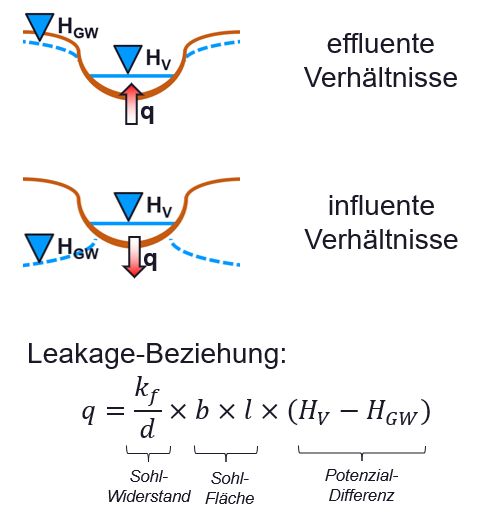Attributes:
LEKN (node wise),
LERA (polyline wise),
LEEL (element wise, horizontal and 3D models only)
These data types are used to specify the leakage coefficient, which represents a linear relationship for the difference between the watercourse level and the groundwater level (hv – hgw) and the leakage rate (q). The following figure shows the general interaction between surface water bodies and groundwater.

General surface water-groundwater interaction
Where:
kf = hydraulic conductivity of the clogging layer [m/s]
d = thickness of the clogging layer [m]
The calculation modules ultimately requires a transformed leakage coefficient L in the time unit [TU] of the mesh file:
L [m²/TU]= α A [s/TU]
which enables the direct calculation of the leakage rate (per TU) from the potential head difference. The proportionate flow area of the bed of the receiving water is denoted by A. The term "[s/TU]" stands for the conversion of the time unit seconds (s) to the time unit of the mesh file (TU). Both the original values (LEKN, LERA, LEEL) and the corresponding converted values for L can be displayed later in a plot.
The following relationships apply between the leakage coefficient α [1/s], the provided data types (LEKN, LERA and LEEL), and L for different geometries:
Node wise (LEKN):

LEKN [m²/TU] = α A [s/TU] i.e. L = LEKN
Polyline wise (LERA):

LERA [m/TU] = αb [s/TU] i.e. L = l * LERA
The proportional section length (l) for each node of the polyline course/stream is included during the model check. It is calculated as the sum of half the distance to each neighbouring nodes of the polyline course. Thus, the order of the nodes is important when entering a polyline-wise leakage coefficient.
Element wise (LEEL):

The value specified under this data type has two possible meanings, depending on the assignment of the UNDU attribute:
If UNDU is not assigned to any of the nodes of the element, or all nodes is equal to 0:
LEEL [1/TU] = α [s/TU] i.e. L = A * LEEL
Then, the element area A is included in the model check.
If UNDU values larger than zero are assigned to at least one node of the element:
LEEL [m/s] = kv [m/s].
The UNDU value therefore specifies the vertical K-value in m/s of the covering layer. The values for UNDU is averaged over all the nodes of the element (If not specified for a node, then UNDU equals zero) and is utilized with the thickness d of the covering layer. The element area A is then included in the final leakage coefficient L in the model check:
L = LEEL / UNDU A [s/TU]
When entering the leakage coefficients, make sure that these values (with the exception of LEEL in combination with UNDU) are provided in the time unit (TU) specified in the model file!
Leakage calculation always requires the additional specification of a reference water level (stage) for watercourses (VORF). Otherwise the leakage data will be ignored.
